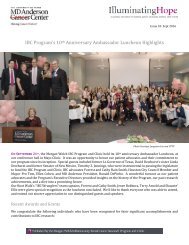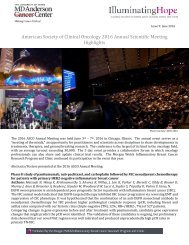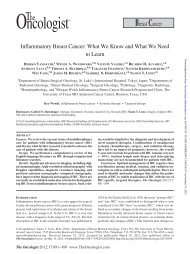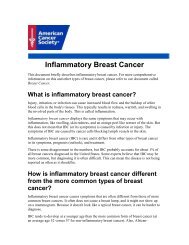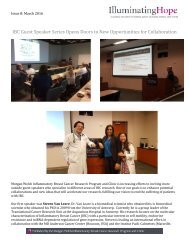Breast Cancer whole genome sequences-Nature May 2016
You also want an ePaper? Increase the reach of your titles
YUMPU automatically turns print PDFs into web optimized ePapers that Google loves.
RESEARCH<br />
ARTICLE<br />
GISTIC 5<br />
GISTIC 4<br />
GISTIC 3<br />
GISTIC 2<br />
GISTIC 1<br />
HRD top 25%<br />
HRD low 25%<br />
GATA3 mut<br />
PIK3CA mut<br />
PTEN mut<br />
RB1 mut<br />
TP53 mut<br />
HER2<br />
PR<br />
ER<br />
A<br />
B<br />
C<br />
D<br />
E<br />
F<br />
G<br />
miRNAcluster<br />
MYC amp<br />
ZNF217 amp<br />
ZNF703 amp<br />
CCND1 amp<br />
ERBB2 amp<br />
Kataegis<br />
BRCA status<br />
AIMS subtype<br />
Figure 5 | Integrative analysis of rearrangement<br />
signatures. Heatmap of rearrangement<br />
signatures following unsupervised hierarchical<br />
clustering based on proportions of<br />
rearrangement signatures in each cancer. Seven<br />
cluster groups (A–G) noted and relationships<br />
with expression (AIMS) subtype (basal, red;<br />
luminal B, light blue; luminal A, dark blue),<br />
immunohistopathology status (ER, progesterone<br />
receptor (PR), HER2 status; black, positive),<br />
abrogation of BRCA1 (purple) and BRCA2<br />
(orange) (whether germline, somatic or through<br />
promoter hypermethylation), presence of 3 or<br />
more foci of kataegis (black, positive), HRD<br />
index (top 25% or lowest 25%; black, positive),<br />
GISTIC cluster group (black, positive) and<br />
driver mutations in cancer genes. miRNA<br />
cluster groups: 0, red; 1, purple; 2, blue; 3, light<br />
blue; 4, green; 5, orange. Contribution of basesubstitution<br />
signatures in these seven cluster<br />
groups is provided in the bottom panel.<br />
A<br />
B<br />
C<br />
D<br />
E<br />
F<br />
G<br />
Rearrangement signature 1<br />
Rearrangement signature 2<br />
Fraction<br />
of<br />
signature<br />
Rearrangement signature 3<br />
Rearrangement signature 4<br />
0 1<br />
Rearrangement signature 5<br />
Rearrangement signature 6<br />
100%<br />
A<br />
B<br />
C<br />
D<br />
E<br />
F<br />
G<br />
80%<br />
Base substitution<br />
signatures<br />
60%<br />
40%<br />
20%<br />
0%<br />
Signatures 1 5 2 13 6 20 26 3 8 18 17 30<br />
<strong>Cancer</strong>s with inactivating BRCA1 or BRCA2 mutations usually carry<br />
many genomic rearrangements. <strong>Cancer</strong>s with BRCA1, but not BRCA2,<br />
mutations exhibit large numbers of rearrangement signature 3 small<br />
tandem duplications. <strong>Cancer</strong>s with BRCA1 or BRCA2 mutations show<br />
substantial numbers of rearrangement signature 5 deletions. No other<br />
rearrangement signatures were associated with BRCA1- or BRCA2-null<br />
cases (clusters D and G, Fig. 5). Some breast cancers without identifiable<br />
BRCA1/2 mutations or BRCA1 promoter methylation showed these<br />
features and segregated with BRCA1/2-null cancers in hierarchical<br />
clustering analysis (Fig. 5). In such cases, the BRCA1/2 mutations may<br />
have been missed or other mutated or promoter methylated genes may be<br />
exerting similar effects (see http://cancer.sanger.ac.uk/cosmic/sample/<br />
<strong>genome</strong>s for examples of <strong>whole</strong>-<strong>genome</strong> profiles of typical BRCA1-<br />
null, (for example, PD6413a, PD7215a) and BRCA2-null tumours (for<br />
example, PD4952a, PD4955a)).<br />
A further subset of cancers (cluster F, Fig. 5) show similarities in<br />
mutational pattern to BRCA1/2-null cancers, with many rearrangement<br />
signature 5 deletions and enrichment for base substitution signatures 3<br />
and 8. However, these do not segregate together with BRCA1/2-null<br />
cases in hierarchical clustering analysis, have rearrangement signature 1<br />
large tandem duplications and do not show BRCA1/2 mutations.<br />
Somatic and germline mutations in genes associated with the DNA<br />
double-strand break repair pathway including ATM, ATR, PALB2,<br />
RAD51C, RAD50, TP53, CHEK2 and BRIP1, were sought in these cancers.<br />
We did not observe any clear-cut relationships between mutations<br />
in these genes and these mutational patterns.<br />
<strong>Cancer</strong>s with BRCA1/2 mutations are particularly responsive to cisplatin<br />
and PARP inhibitors 43–45 . Combinations of base substitution, indel<br />
and rearrangement mutational signatures may be better biomarkers<br />
of defective homologous-recombination-based DNA double-strand<br />
break repair and responsiveness to these drugs 46 than BRCA1/2 mutations<br />
or promoter methylation alone and thus may constitute the basis<br />
of future diagnostics.<br />
Conclusions<br />
A comprehensive perspective on the somatic genetics of breast cancer<br />
is drawing closer (see http://cancer.sanger.ac.uk/cosmic/sample/<br />
<strong>genome</strong>s for individual patient <strong>genome</strong> profile, and Methods for<br />
orientation). At least 12 base substitution mutational signatures and 6<br />
rearrangement signatures contribute to the somatic mutations found,<br />
and 93 mutated cancer genes (31 dominant, 60 recessive, 2 uncertain)<br />
are implicated in genesis of the disease. However, dominantly<br />
acting activated fusion genes and non-coding driver mutations appear<br />
rare. Additional infrequently mutated cancer genes probably exist.<br />
6 | NATURE | VOL 000 | 00 MONTH <strong>2016</strong><br />
© <strong>2016</strong> Macmillan Publishers Limited. All rights reserved



